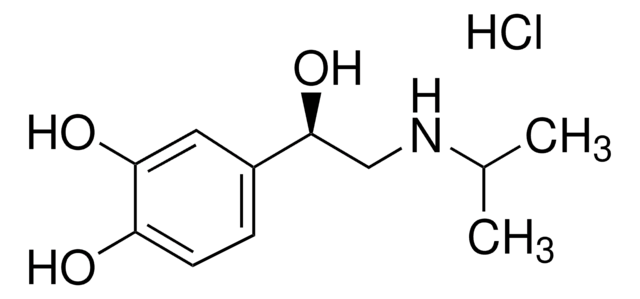537075
(±)-Propranolol, Hydrochloride
A highly lipophilic agent that blocks both β₁ and β₂ adrenergic receptors with equal potency.
Synonym(s):
(±)-Propranolol, Hydrochloride, (±)-1-(Isopropylamino)-3-(1-naphthyloxy)-2-propanol, HCl
About This Item
Recommended Products
Quality Level
assay
≥97% (HPLC)
form
powder
manufacturer/tradename
Calbiochem®
storage condition
OK to freeze
color
white
solubility
methanol: soluble
water: soluble
shipped in
ambient
storage temp.
−20°C
InChI
1S/C17H23NO2.ClH/c1-13(2)10-18-11-15(19)12-20-17-9-5-7-14-6-3-4-8-16(14)17;/h3-9,13,15,18-19H,10-12H2,1-2H3;1H
InChI key
RTTYPFXTLKDXPS-UHFFFAOYSA-N
General description
Biochem/physiol Actions
β1 and β2 adrenergic receptors
Warning
Reconstitution
Other Notes
Glennon, R.A., et al. 1996. Mol. Pharmacol.49, 198.
Thompson, N.T., et al. 1991. Trends Pharmacol. Sci.12, 404.
Hoffman, B.B., and Lefkowitz, R.J. 1990. in The Pharmacological Basis of Therapeutics (Gilman, A.G., et al., Eds.) p. 221, Pergamon Press, New York.
Legal Information
signalword
Warning
hcodes
Hazard Classifications
Acute Tox. 4 Oral
Storage Class
11 - Combustible Solids
wgk_germany
WGK 3
flash_point_f
Not applicable
flash_point_c
Not applicable
Certificates of Analysis (COA)
Search for Certificates of Analysis (COA) by entering the products Lot/Batch Number. Lot and Batch Numbers can be found on a product’s label following the words ‘Lot’ or ‘Batch’.
Already Own This Product?
Find documentation for the products that you have recently purchased in the Document Library.
Customers Also Viewed
Our team of scientists has experience in all areas of research including Life Science, Material Science, Chemical Synthesis, Chromatography, Analytical and many others.
Contact Technical Service








